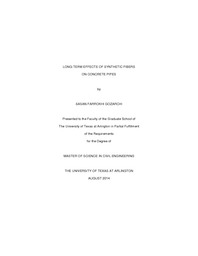
ATTENTION: The works hosted here are being migrated to a new repository that will consolidate resources, improve discoverability, and better show UTA's research impact on the global community. We will update authors as the migration progresses. Please see MavMatrix for more information.
Show simple item record
| dc.contributor.author | Farrokhi Gozarchi, Sasan | en_US |
| dc.date.accessioned | 2014-07-14T20:22:32Z | |
| dc.date.available | 2014-07-14T20:22:32Z | |
| dc.date.issued | 2014-07-14 | |
| dc.date.submitted | January 2014 | en_US |
| dc.identifier.other | DISS-12735 | en_US |
| dc.identifier.uri | http://hdl.handle.net/10106/24409 | |
| dc.description.abstract | The studies undertaken by this research were to evaluate the long-term performance and durability of synthetic fiber-reinforced concrete pipes. The target long-term performance is for 9000 hours. Two sets of pipes 8 ft. (2400 mm) long with inside diameters of 24 in. (600 mm) and 36 in. (1200 mm) were manufactured, with a wall thickness of 3 and 4 in., respectively. The pipes were produced based on ASTM C76, for a Class III type with a Wall B. The two set of pipes included RCP's (as control) and SYN-FRCP's. The SYN-FRCP's had several fiber dosages ranging from 6 lb/yd3 (3.5 kg/m3) to 12 lb/yd3 (7.0 kg/m3) in order to evaluate the long-term performance of synthetic fiber-reinforced concrete pipes. The pipes were pre-cracked until the first visible crack was observed in the three-edge bearing test. As a result, the sustained load simulated, was calculated from the Peak D-load observed; and also the appropriate fiber dosages required for the 24. in (600 mm) and 36 in. (900 mm) pipes were obtained .Three of the 24 in. and three of the 36 in. pipes were installed in 7 ft. (2100 mm) and 8 ft. (2400 mm) wide trenches with 16 ft. (4800 mm) and 18 ft. (5500 mm) of cover respectively. The pipe was initially backfilled with native soil up to 2 ft. (600 mm) and 4 ft. (1200 mm) over the top of the pipe then backfilled again with pea-gravel weighing 100 lb/ft3, to a height of 14ft. to simulate the sustained loading. A type two installation was used during the development of the test setup.Once the long-term test set up was complete, the data was immediately recorded, and vertical deflections were observed from the time-dependent behavior of the pipes. It was observed from results obtained from the three-edge bearing test, that synthetic fibers improve the mechanical properties of concrete pipes, in dry-cast manufacturing. Also, it was observed from the time-dependent deformation, that there was no significant deformation of SYN-FRCP, while the shear capacity was enhanced. Based on the long-term monitoring of the buried pipes, it was observed that the increase in vertical deformation of the SYN-FRCP compared to RCP, over time, was not significant. | en_US |
| dc.description.sponsorship | Abolmaali, Ali | en_US |
| dc.language.iso | en | en_US |
| dc.publisher | Civil & Environmental Engineering | en_US |
| dc.title | Long-term Effects Of Synthetic Fibers On Concrete Pipes | en_US |
| dc.type | M.Engr. | en_US |
| dc.contributor.committeeChair | Abolmaali, Ali | en_US |
| dc.degree.department | Civil & Environmental Engineering | en_US |
| dc.degree.discipline | Civil & Environmental Engineering | en_US |
| dc.degree.grantor | University of Texas at Arlington | en_US |
| dc.degree.level | masters | en_US |
| dc.degree.name | M.Engr. | en_US |
Files in this item
- Name:
- FARROKHIGOZARCHI_uta_2502M_127 ...
- Size:
- 9.765Mb
- Format:
- PDF
This item appears in the following Collection(s)
Show simple item record


